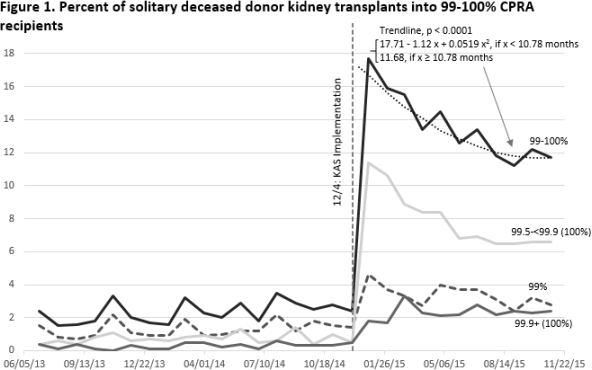99% and 100% CPRA Patients Since KAS: A Substantial Increase in Transplants with Strong Evidence of a Bolus Effect.
1UNOS, Richmond, VA
2Univ Hosp Case Med Ctr, Cleveland, OH
3Emory Univ Hosp, Atlanta, GA.
Meeting: 2016 American Transplant Congress
Abstract number: 515
Keywords: Allocation, Kidney transplantation, Sensitization
Session Information
Session Name: Concurrent Session: Kidney Waitlist Management and KAS Initial Results
Session Type: Concurrent Session
Date: Tuesday, June 14, 2016
Session Time: 4:30pm-6:00pm
 Presentation Time: 4:30pm-4:42pm
Presentation Time: 4:30pm-4:42pm
Location: Veterans Auditorium
Background: The Kidney Allocation System (KAS), implemented on 12/4/14, increased allocation priority for candidates with CPRA of 99-100%. Analyses performed on behalf of the OPTN Kidney Transplantation Committee predicted a substantial increase in the % of txs going to patients with CPRA of 99-100% and the possibility of a gradual decrease over time due to a “bolus” effect.
Data and Methods: OPTN data were used for the analyses. Trends in the % of all solitary deceased donor kidney (KI) txs performed in CPRA 99-100% recipients were analyzed pre-KAS (6/1/13-12/3/14) vs. post-KAS (12/4/14-10/31/15). A trendline was fit for post-KAS using nonlinear, piecewise regression. Changes in the prevalence of CPRA 99-100% patients on the KI waiting list (WL) over time were also examined.
Results: The % of txs into CPRA 99-100% recipients increased from 2.3% Pre-KAS to 17.7% in the first month post-KAS (Fig 1). The % tapered in the 1st 6 months post-KAS (29% decrease from the 1st to 6th month) and has remained relatively steady at approximately 11-12% in months 7-10.
The number of WL candidates with a CPRA of 99-100% decreased during the period of 11/30/14 to 10/31/15 by 11.0% for 99%, 20.2% for 99.5-<99.9% and 4.4% for 99.9%+ (Fig 2).


Conclusions: Under KAS, candidates with a CPRA of 99-100% have experienced a markedly higher rate of transplantation than pre KAS, with a bolus effect during the first few months that appears to be nearing a steady state. These data confirm the intended increased access to transplantation for highly sensitized candidates that was observed for all subgroups including the 99.9%+. Further monitoring and studies are needed to characterize differences between highly sensitized recipients vs. those remaining on the WL.
CITATION INFORMATION: Kucheryavaya A, Aeder M, Turgeon N, Klassen D, Stewart D. 99% and 100% CPRA Patients Since KAS: A Substantial Increase in Transplants with Strong Evidence of a Bolus Effect. Am J Transplant. 2016;16 (suppl 3).
To cite this abstract in AMA style:
Kucheryavaya A, Aeder M, Turgeon N, Klassen D, Stewart D. 99% and 100% CPRA Patients Since KAS: A Substantial Increase in Transplants with Strong Evidence of a Bolus Effect. [abstract]. Am J Transplant. 2016; 16 (suppl 3). https://atcmeetingabstracts.com/abstract/99-and-100-cpra-patients-since-kas-a-substantial-increase-in-transplants-with-strong-evidence-of-a-bolus-effect/. Accessed December 24, 2025.« Back to 2016 American Transplant Congress
